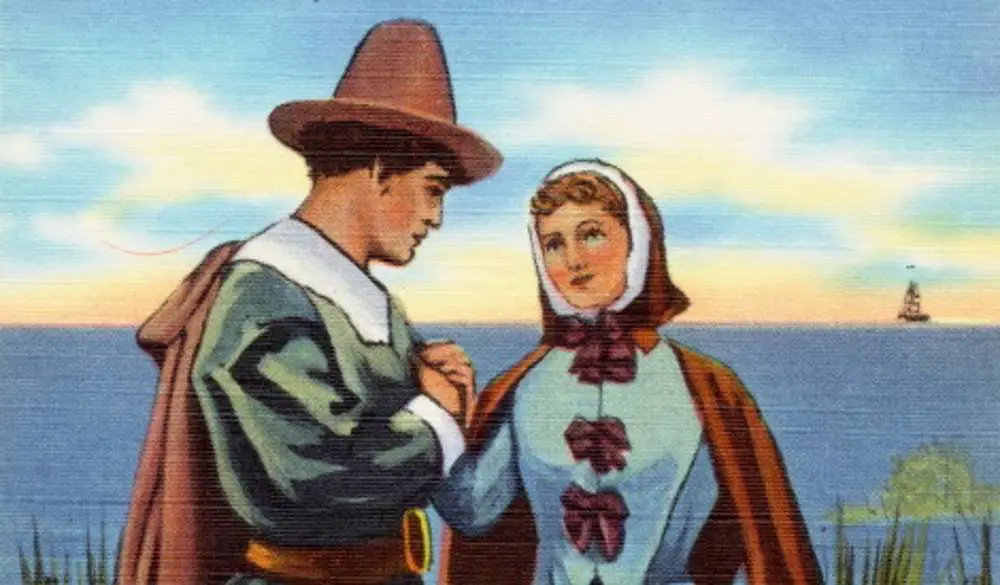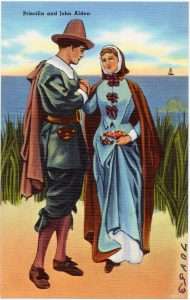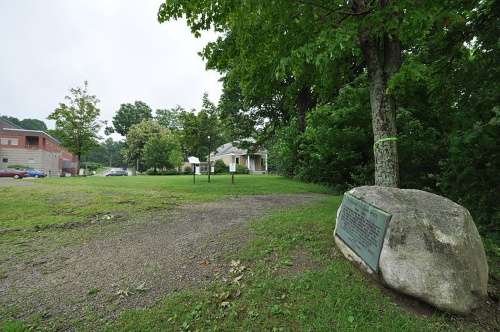Most school children know the story of John Alden and Priscilla Mullins, but few know he went to jail for murder.
He didn’t stay long, and he didn’t do it, but the story reminds us that the Pilgrims strayed far from Plymouth Colony. They had a trading business in Maine that did so well it let them repay their considerable debt to their financial backers.
John Alden
Not much is known about John Alden until he met the Pilgrims as a 21-year-old in Southampton, England. They hired him as the Mayflower’s cooper, to make the barrels and casks that carried all the food, drink, clothing and gunpowder on board the ship.
Alden could have gone back to England, but he chose to stay. It was a wise choice. He emerged as a leader of Plymouth Colony, serving on the Governor’s Council and as treasurer, deputy to the General Court and a member of the Council of War.
Alden also belonged to the group of eight who assumed a large debt.
London merchants had underwritten their Mayflower voyage and provisions to establish Plymouth Colony. The Pilgrims, however, had a hard time repaying them during those lean first years—in fact, they ended up borrowing even more.
But they made a deal in 1626 that bought them time. The merchants’ partnership broke up, and eight colonists agreed to assume their debt in exchange for a monopoly on the fur trade along the Kennebec River in Maine.
The Kennebec Patent
The year before they made that deal, Plymouth Colony had had a good harvest with enough surplus corn to trade. “It pleased ye Lord to give ye plantation peace and health and contented minds, and so to bless their labours, and they had corne sufficient, (and some to spare to others,) with other foode,” wrote William Bradford.
A handful of young men, including John Howland, loaded the surplus corn into a shallop that came with them in the Mayflower. They then sailed it up the coast of Maine and up the mouth of the Kennebec River. At the head of the river they came upon an Abenaki village, where they traded the corn for 700 pounds of beaver fur.
That highly profitable trip convinced the colonists to set up a trading post, in what was known as Koussinoc or Cushnoc. Today it’s known as Augusta.
The Plymouth colonists managed to obtain a patent for the land along the Kennebec and to build a bigger boat to carry on their trade. They built a trading house and stocked it with trade goods: “coats, shirts, ruggs, & blankets, biskett, pease, prunes” and, of course, corn, according to Bradford.
Exporting beaver furs to Europe was a lucrative business. The Cushnoc trading post made enough profit for the Plymouth colonists to pay back their creditors in 12 years. They ran the trading post for 40.
But why did they have to go all the way to Maine to trade with indigenous people for beaver fur? Because Myles Standish had made an ill-considered attack on two Massachusett leaders, luring them to a meal and then killing them. That pretty much ruined relations with the local tribes with whom the Pilgrims had traded furs.
Another question: Why is history so silent on the Plymouth colonists’ trading post at Cushnoc? Some have speculated that the colonists themselves didn’t want word to get out about their money-making operation.
Murder on the Kennebec
John Howland ran the trading post for several years. John Alden, along with other Pilgrims such as Edward Winslow and William Bradford, visited Cushnoc to bring supplies.
Alden had come to Cushnoc in the spring of 1634 when a dispute broke out over trading rights. A man named John Hocking, or possibly Hoskins, from Piscataqua (New Hampshire) sailed up the Kennebec in a boat owned by his bosses, Lord Brook and Lord Saye (from whom Saybrook, Conn., took its name).
Hocking sailed past Cushnoc to trade with the Indians who would paddle down the Kennebec with canoes full of furs. The Plymouth colonists maintained they had exclusive rights to trade in the area and told Hocking to leave. Hocking refused, anchoring his vessel in the river.
John Alden, deputy governor at the time, told Howland to cut Hocking’s line. So Howland ordered four of his men to cut the cable to Hocking’s bark. They took a canoe into the river, and paddled toward Hocking, who threatened to shoot them unless they stopped. The Plymouth men cut one anchor cable, and then tried to cut the other. Hocking shot one man, Moses Talbot, dead.
The three remaining men returned fire, shooting John Hocking in the head and killing him.
“The rest of ye men carried home the vessel and ye sad tidings of these things,” wrote Bradford.
John Alden, Jailbird
Several months later, John Alden visited Boston on business, and the General Court ordered him jailed. A relative of John Hocking had brought a complaint against Alden.
Massachusetts Bay Colony had no jurisdiction over Plymouth or Kennebec, but went ahead and arrested him anyway. John Winthrop explained in his journal that they feared the king would send over a governor general once he got word of the unpleasantness at Kennebec. And the Puritans of Massachusetts Bay Colony wished to continue to govern themselves.
William Bradford sent Myles Standish to Boston to explain what happened, and Gov. Thomas Dudley set Alden free.
The Courtship of Priscilla and John Alden
What may not have happened to John Alden got far more historical recognition than what did happen.
Henry Wadsworth Longfellow wrote the poem The Courtship of Miles Standish about a love triangle between Alden, Standish and Priscilla Mullins. Longfellow, through his mother, was descended from John and Priscilla. He claimed the story came down through his family.
In the tale, John Alden and Myles Standish are roommates in Plymouth Colony in 1621. Both have their eyes on Priscilla who was, in fact, the only marriageable woman in the colony at the time. Standish asks Alden to propose to Priscilla on his behalf. Priscilla replied, “Why don’t you speak for yourself, John?”
Historian John Goodwin wrote there’s no reason for believing any of it. The story of John Alden going to jail, however, is true.
With thanks to Nathaniel Philbrick, Mayflower: A Story of Courage, Community, and War. Image of Cushnoc site By Magicpiano – Own work, CC BY-SA 3.0, https://commons.wikimedia.org/w/index.php?curid=280178. This story was updated in 2024.



